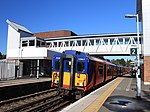Pixham

Pixham is a chapelry (small village) within the parish of Dorking, Surrey on the near side of the confluence of the River Mole and the Pipp Brook to its town, Dorking, which is centred 1 km (0.6 mi) southwest. The town as a whole, uniquely in Surrey, has three railway stations; Pixham adjoins or is the location of two of the three; and is near the junction of the A24 and A25 main roads. Until 1910 watermills principally for corn grinding and for fulling at Pixham Mill operated, however its agricultural land has been converted to other use. At the 2011 Census the main land use was residential land; its main business being the head office of Friends Provident (which has since been taken over by Aviva), small employers include a school, large inn and a waste water treatment works. Pixham covers 117 hectares (290 acres).
Excerpt from the Wikipedia article Pixham (License: CC BY-SA 3.0, Authors, Images).Pixham
Pixholme Grove, Mole Valley
Geographical coordinates (GPS) Address Nearby Places Show on map
Geographical coordinates (GPS)
| Latitude | Longitude |
|---|---|
| N 51.2407 ° | E -0.31957 ° |
Address
Pixholme Grove
Pixholme Grove
RH4 1PJ Mole Valley
England, United Kingdom
Open on Google Maps










